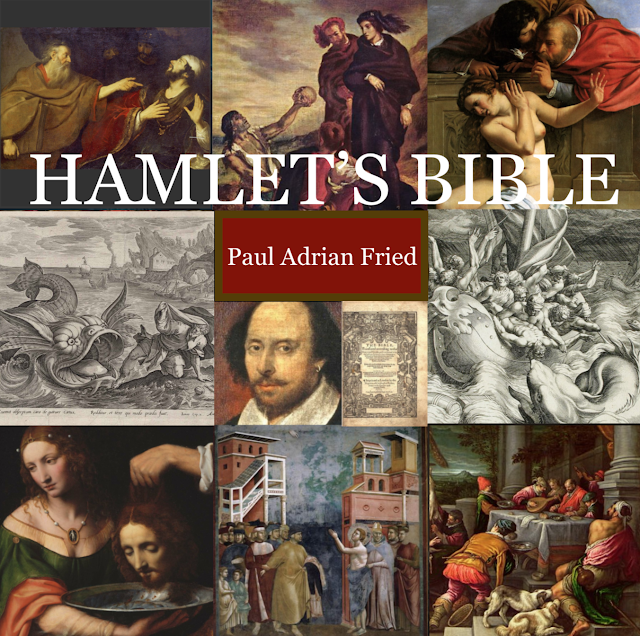Good Friday/Christ’s Passion Allusions in Hamlet
Christianity has long used the Friday before Easter to commemorate the story of the betrayal, torture, crucifixion, and death of Jesus. These stories are retold in the Bible (Mark 14-15, Matthew 26-27, Luke 22-23, John 18-19).
[Image: David Tennant in 2008 RSC production of Hamlet, directed by Gregory Doran. Via BBC. Fair use.]
Shakespeare’s Hamlet echoes a number of details from these stories and from larger Christian tradition. (See also Shaheen.)
A few examples: [1]
1.1.125-137: Horatio describes the dead rising and strange signs in the heavens upon the death of Julius Caesar, but Matthew 27:53 similarly describes the dead raised at the moment of Jesus' death, and Luke 23:44-45 describes an eclipse.
1.1.162 and 163-4: The ghost hears the cock crow, and Horatio comments, “it started like a guilty thing / Upon a fearful summons.” Each of the gospels tells of Jesus predicting that Peter will deny him, and later, that the prediction comes true, marked by the crowing of a cock. So in this way, the guilt of the ghost is compared to Peter’s denial of Christ.
The next possible allusion may be read differently by Catholics and Protestants:
2.2.555: As noted in my post yesterday, Hamlet scolds Polonius for being ungenerous about the player's lodging, using the phrase, “God’s bodykins."
- Some claim this may point to Catholic Eucharist ("God's dear body," OED, or Christ's little bodies), but others say it refers to nails believed to have been used in the crucifixion.
- Some Protestant scholars and editors may prefer to avoid the possible Catholic allusion in favor of the other suggested meaning, that “God’s Bodykins” (or “Od’s Bodkins”) refers to the nails traditionally believed to have been used in the crucifixion.
2.2.603 and 5.1.290: Hamlet says “‘Swounds.” This is short for “By Christ’s wounds!” and can be compared to when people in frustration say “For the love of Christ!”
- Like Polonius saying “By the mass!” in 2.1.56-8 and 3.2.408, Hamlet’s use of the word or abbreviated phrase would be considered blasphemous, but it may have been common.
- “Christ’s wounds” would include those mentioned in the gospel of John to the hands (and by tradition, feet), and to his side as in John 19:34.
5.2.321: Gertrude offers to wipe the sweaty brow of Hamlet who is dueling with Laertes. (I posted about this previously.)
In a 1984 journal article, David Kaula mentions the similarity of Gertrude offering to wipe the brow of Hamlet, to Veronica wiping the face of Jesus on the way to the crucifixion. This is not based on a gospel story, but rather, on Christian tradition or legend.
"Golgotha" where Jesus was crucified means "skull," so the famous image of Hamlet holding the skull of Yorick also echoes Golgotha and the crucifixion.
NOTES:
[1] All references to Hamlet are to the Folger Shakespeare Library online version: https://shakespeare.folger.edu/shakespeares-works/hamlet/entire-play/
~~~~~~~~~~~~~~~~~~~~~~~~
Disclaimer: If and when I quote or paraphrase bible passages or mention religion in many of my blog posts, I do not intend to promote any religion over another, nor am I attempting to promote religious belief in general; only to point out how the Bible and religion may have influenced Shakespeare, his plays, and his age.
~~~~~~~~~~~~~~~~~~~~~~~~
~~~~~~~~~~~~~~~~~~~~~~~~~~~~~~~~~~~~~~
Thanks for reading!
~~~~~~~~~~~~~~~~~~~~~~~~~~~~~~~~~~~~~~
My current project is a book tentatively titled Hamlet’s Bible, about biblical allusions and plot echoes in Hamlet.
Below is a link to a list of some of my top posts (“greatest hits”), including a description of my book project (last item on the list):
https://pauladrianfried.blogspot.com/2019/12/top-20-hamlet-bible-posts.html
I post every week, so please visit as often as you like and consider subscribing.

[Image: David Tennant in 2008 RSC production of Hamlet, directed by Gregory Doran. Via BBC. Fair use.]
Shakespeare’s Hamlet echoes a number of details from these stories and from larger Christian tradition. (See also Shaheen.)
A few examples: [1]
1.1.125-137: Horatio describes the dead rising and strange signs in the heavens upon the death of Julius Caesar, but Matthew 27:53 similarly describes the dead raised at the moment of Jesus' death, and Luke 23:44-45 describes an eclipse.
1.1.162 and 163-4: The ghost hears the cock crow, and Horatio comments, “it started like a guilty thing / Upon a fearful summons.” Each of the gospels tells of Jesus predicting that Peter will deny him, and later, that the prediction comes true, marked by the crowing of a cock. So in this way, the guilt of the ghost is compared to Peter’s denial of Christ.
The next possible allusion may be read differently by Catholics and Protestants:
2.2.555: As noted in my post yesterday, Hamlet scolds Polonius for being ungenerous about the player's lodging, using the phrase, “God’s bodykins."
- Some claim this may point to Catholic Eucharist ("God's dear body," OED, or Christ's little bodies), but others say it refers to nails believed to have been used in the crucifixion.
- Some Protestant scholars and editors may prefer to avoid the possible Catholic allusion in favor of the other suggested meaning, that “God’s Bodykins” (or “Od’s Bodkins”) refers to the nails traditionally believed to have been used in the crucifixion.
2.2.603 and 5.1.290: Hamlet says “‘Swounds.” This is short for “By Christ’s wounds!” and can be compared to when people in frustration say “For the love of Christ!”
- Like Polonius saying “By the mass!” in 2.1.56-8 and 3.2.408, Hamlet’s use of the word or abbreviated phrase would be considered blasphemous, but it may have been common.
- “Christ’s wounds” would include those mentioned in the gospel of John to the hands (and by tradition, feet), and to his side as in John 19:34.
5.2.321: Gertrude offers to wipe the sweaty brow of Hamlet who is dueling with Laertes. (I posted about this previously.)
In a 1984 journal article, David Kaula mentions the similarity of Gertrude offering to wipe the brow of Hamlet, to Veronica wiping the face of Jesus on the way to the crucifixion. This is not based on a gospel story, but rather, on Christian tradition or legend.
"Golgotha" where Jesus was crucified means "skull," so the famous image of Hamlet holding the skull of Yorick also echoes Golgotha and the crucifixion.
NOTES:
[1] All references to Hamlet are to the Folger Shakespeare Library online version: https://shakespeare.folger.edu/shakespeares-works/hamlet/entire-play/
~~~~~~~~~~~~~~~~~~~~~~~~
Disclaimer: If and when I quote or paraphrase bible passages or mention religion in many of my blog posts, I do not intend to promote any religion over another, nor am I attempting to promote religious belief in general; only to point out how the Bible and religion may have influenced Shakespeare, his plays, and his age.
~~~~~~~~~~~~~~~~~~~~~~~~
~~~~~~~~~~~~~~~~~~~~~~~~~~~~~~~~~~~~~~
Thanks for reading!
~~~~~~~~~~~~~~~~~~~~~~~~~~~~~~~~~~~~~~
My current project is a book tentatively titled Hamlet’s Bible, about biblical allusions and plot echoes in Hamlet.
Below is a link to a list of some of my top posts (“greatest hits”), including a description of my book project (last item on the list):
https://pauladrianfried.blogspot.com/2019/12/top-20-hamlet-bible-posts.html
I post every week, so please visit as often as you like and consider subscribing.


Comments
Post a Comment